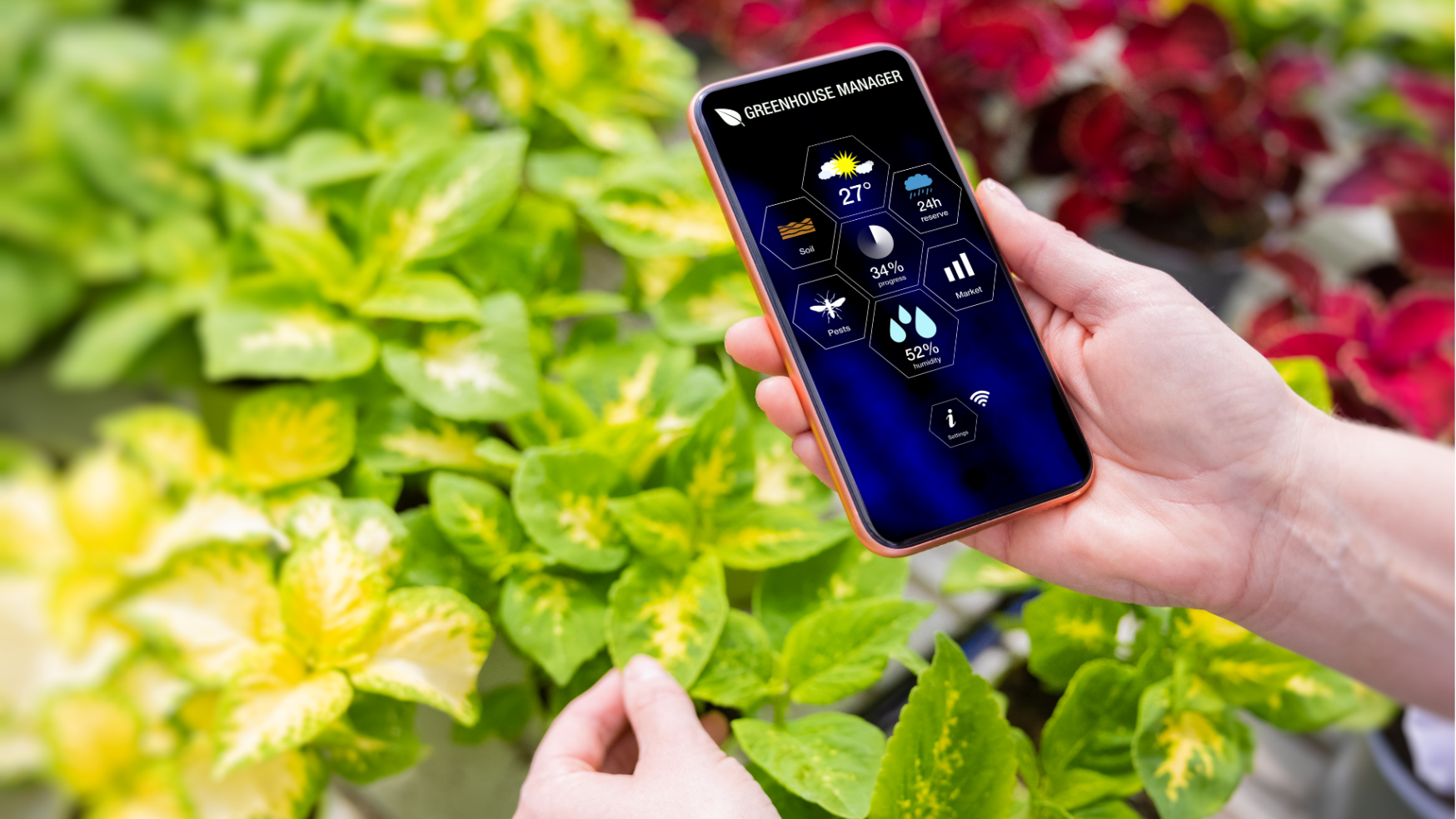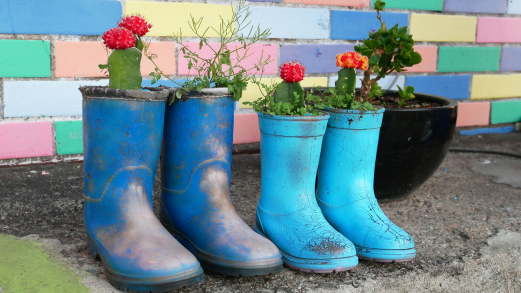
The Replenish Garden is as much a sustainable garden as an art installation, and a multi award-winning one at that.
The garden is tucked away inside the Visy Recycling operation in Melbourne’s north-eastern suburb of Bellfield. In fact, the entrance is a bit of a secret – tucked down the side of the facility next to a bike track (shown here), planted with indigenous vegetation. The entrance has an intercom for access (so it’s strictly by appointment)!
The garden demonstrates the importance of waste minimisation, and resource conservation and recovery and has won seven awards in its six years of existence, including one from the Royal Australian Institute of Landscape Architects (Vic & Tas).
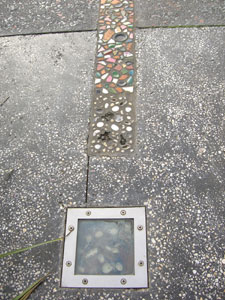
The recycling operation is on a 2.8 hectare site and sorts the kerbside collection of recyclables (paper, glass, aluminium and plastic) from 265,000 households. Unfortunately SGA wasn’t allowed to take photos of the actual recycling operation. However, it is quite astonishing in its complexity and ability to sort and pack recyclables to be sent to various processing plants.
The facility has an education room called Rethink, which provides information on recycling.
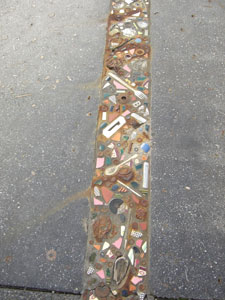
Maree Pollard, Rethink Centre Coordinator, who showed SGA around the facility, explains that they host tour groups from Prep school age through to elderly citizens.
‘The information can be quite dry, so Visy employs professional actors who get the message across in song and movement. And because it is presented in a fun and entertaining way, the children respond to it,’ explains Maree. ‘In fact, the adults enjoy it as much as children because we subvert popular songs and often this goes over the heads of the children!’
The garden is a mix of exotic, native and indigenous plants, and Maree explains that avoiding environmental weeds is also an important aspect.
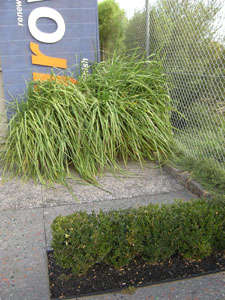
The garden began with the input of three visual artists, then AQL (Australian Quality Landscapes) were commissioned to design and construct.
There are many layers of meaning expressed in the garden. For example, the inlay of rubbish shown here, known as Retrace, takes us from the middens of indigenous Australia, the rubbish of settlement to the waste of modern times – entitled Midden, Settlement, Machine, and Information.
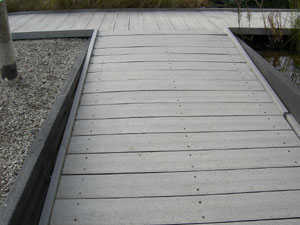
The change in vegetation is also expressed in the garden. Seen here is a large clump of lomandras and in the foreground is the icon of the English landscape, English Box (Buxus sempervirens). The next clump, which we can’t see, is a traditional lawn, and the following one shows native grasses, which reflects the change in garden design.
A boardwalk links the areas of the garden and is made from recycled plastic. The structural bearers supporting the boardwalk are also made from recycled plastic. This product is now available from Repeat Products, Lilydale, Victoria, in a variety of finishes.

Recycled rubber crumbs, as shown here in the acrylic cylinder, has been used with surprising success as mulch. Initially there had been concerns about using it because toxicity to plants was unknown. It turned out to have a lot of advantages. There is no nitrogen drawdown as experienced with organic mulches. It doesn’t break down, so there is no need to replace it periodically. The blackbirds don’t flick it around because there are no insects attracted to it, and it must work as a water-conserving mulch because the plants have responded very favourably.
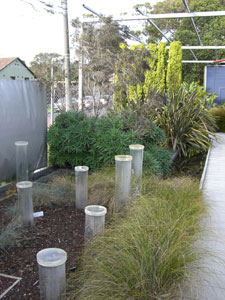
One of the most interesting aspects of the garden is the compost vials, designed by visual artist Chaco Kato. The acrylic vials demonstrate composting at work. The vials are partly submerged in the soil and Maree fills them with layers of green waste procured from the local greengrocer. She confesses that she often goes to a bit of trouble with the layering effect so that the vials look colourful and eye-catching! And they really do work. As can be seen here, they are in need of a top-up, as Maree explains that the compost process works very quickly and effectively.
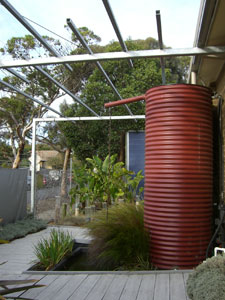
Of course, it wouldn’t be a sustainable garden without a water tank. The tank provides water to the garden and the water features.
The water features are home to a wonderful array of macro inverbrate larva (larger insects), such as kaddisfly, dragonfly, and damsel fly. Maree says visitors enjoy seeing these creatures emerge from their larval state to sit on the stems of the rushes to dry their new wings.
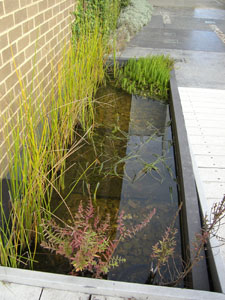
The glass garden, shown here with its recycled blue glass chips mulch, is due for a refurbishment, as is some other areas of the garden.
‘It’s all due for a bit of a makeover, really,’ says Maree. ‘It’s mainly because we like to keep abreast of new gardening practices.’
The internal entrance to the garden features a huge mural made from recycled materials by children, under the guidance of artists. The dog, for example, is made from the plastic coating on electric wires! And the ‘light’ is, as can be seen, quite an interesting ‘hodge-podge’ of recycled materials!
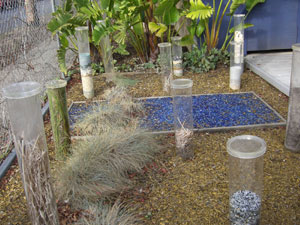
While you can’t take photos of the recycling operation, you can visit the garden and take photographs, but you do need to make an appointment – as a tour group. Primary aged children love it but so do adults. The facility is at 307 Waterdale Road, Bellfield. For tour information, phone Maree Pollard 03 9490 4532, or email maree.pollard@banyule.vic.gov.au



Related Articles:
Citizen Science: A Pathway to Gardening Success and Biodiversity Conservation
In recent years, the realm of science has experienced a remarkable transformation, one that invites people from all walks of life to participate…
A Sustainable Gardener’s Guide to Thrifty Gardening
Creating an eco-friendly and cost-effective garden involves more than just nurturing plants; it's about adopting a sustainable approach that…


